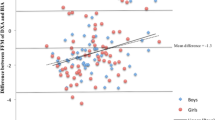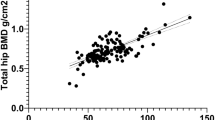Abstract
Objective
The gold standard for diagnosing metabolic bone disease in pediatrics is dual-energy x-ray absorptiometry (DXA). Bone quantitative ultrasound (QUS) has increasing applications. This study compared the relationship of DXA to QUS in preterm infants.
Design
Prospective observational study of preterm infants ≤32 weeks gestation or ≤1800 grams at birth. DXA scans measuring bone mineral content (BMC) and tibial QUS scans measuring bone speed of sound (SOS) were obtained near term gestation.
Results
41 infants had bone scans at mean corrected gestation 37.7 ± 2.1 weeks. BMC and SOS showed weak inverse correlation (R2 0.163, p < 0.01). BMC and SOS correlated with parameters at corrected gestational age at the time of the bone scans (p < 0.05–0.001). SOS correlated with birth gestational age (p < 0.001), not BMC.
Conclusions
A statistically significant weak inverse correlation between DXA and QUS was observed. QUS may have advantages over DXA.
This is a preview of subscription content, access via your institution
Access options
Subscribe to this journal
Receive 12 print issues and online access
$259.00 per year
only $21.58 per issue
Buy this article
- Purchase on Springer Link
- Instant access to full article PDF
Prices may be subject to local taxes which are calculated during checkout



Similar content being viewed by others
Data availability
Available upon request with permission from the involved Institutional Review Board.
References
Chacham S, Pasi R, Chegondi M, Ahmad N, Mohanty SB. Metabolic bone disease in premature neonates: an unmet challenge. J Clin Res Pediatr Endocrinol. 2020;12:332–9.
Chinoy A, Mughal MZ, Padidela R. Current status in therapeutic interventions of neonatal bone mineral metabolic disorders. Semin Fetal Neonatal Med. 2020;25:101075.
Czech-Kowalska J. Mineral and nutritional requirements of preterm infant. Semin Fetal Neonatal Med. 2020;25:101071.
Schulz EV, Wagner CL. History, epidemiology, and prevalence of neonatal bone mineral metabolic disorders. Semin Fetal Neonatal Med. 2020;25:101069.
Faienza MF, D’Amato E, Natale MP, Grano M, Chiarito M, Brunetti G, et al. Metabolic bone disease of prematurity: diagnosis and management. Front Pediatr. 2019;7:143.
Rustico SE, Calabria AC, Garber SJ. Metabolic bone disease of prematurity. J Clin Transl Endocrinol. 2014;1:85–91.
Rayannavar A, Calabria AC. Screening for metabolic bone disease of prematurity. Semin Fetal Neonatal Med. 2020;25:101086.
Gallo S, Vanstone CA, Weiler HA. Normative data for bone mass in healthy term infants from birth to 1 year of age. J Osteoporos. 2012;2012:672403.
Ramot R, Kachhawa G, Kulshreshtha V, Varshney S, Sankar MJ, Devasenathipathy K, et al. Bone mass in newborns assessed by DXA - A systematic review and meta-analysis. Indian J Endocrinol Metab. 2019;23:198–205.
Shalof H, Dimitri P, Shuweihdi F, Offiah AC. Which skeletal imaging modality is best for assessing bone health in children and young adults compared to DXA? A systematic review and meta-analysis. Bone 2021;150:116013.
Shuhart CR, Yeap SS, Anderson PA, Jankowski LG, Lewiecki EM, Morse LR, et al. Executive Summary of the 2019 ISCD Position Development Conference on Monitoring Treatment, DXA Cross-calibration and Least Significant Change, Spinal Cord Injury, Peri-prosthetic and Orthopedic Bone Health, Transgender Medicine, and Pediatrics. J Clin Densitom. 2019;22:453–71.
Baroncelli GI. Quantitative ultrasound methods to assess bone mineral status in children: technical characteristics, performance, and clinical application. Pediatr Res. 2008;63:220–8.
McDevitt H, Tomlinson C, White MP, Ahmed SF. Changes in quantitative ultrasound in infants born at less than 32 weeks’ gestation over the first 2 years of life: influence of clinical and biochemical changes. Calcif Tissue Int. 2007;81:263–9.
Tong L, Gopal-Kothandapani JS, Offiah AC. Feasibility of quantitative ultrasonography for the detection of metabolic bone disease in preterm infants - systematic review. Pediatr Radio. 2018;48:1537–49.
McDevitt H, Tomlinson C, White MP, Ahmed SF. Quantitative ultrasound assessment of bone in preterm and term neonates. Arch Dis Child Fetal Neonatal Ed. 2005;90:F341–2.
Rack B, Lochmüller EM, Janni W, Lipowsky G, Engelsberger I, Friese K, et al. Ultrasound for the assessment of bone quality in preterm and term infants. J Perinatol. 2012;32:218–26.
Ashmeade T, Pereda L, Chen M, Carver JD. Longitudinal measurements of bone status in preterm infants. J Pediatr Endocrinol Metab. 2007;20:415–24.
Chen HL, Tseng HI, Yang SN, Yang RC. Bone status and associated factors measured by quantitative ultrasound in preterm and full-term newborn infants. Early Hum Dev. 2012;88:617–22.
Chen HL, Lee WT, Lee PL, Liu PL, Yang RC. Postnatal changes in tibial bone speed of sound of preterm and term infants during infancy. PLoS One. 2016;11:e0166434.
Fewtrell MS, Loh KL, Chomtho S, Kennedy K, Hawdon J, Khakoo A. Quantitative ultrasound (QUS): a useful tool for monitoring bone health in preterm infants? Acta Paediatr. 2008;97:1625–30.
McDevitt H, Ahmed SF. Quantitative ultrasound assessment of bone health in the neonate. Neonatology 2007;91:2–11.
Yiallourides M, Savoia M, May J, Emmerson AJ, Mughal MZ. Tibial speed of sound in term and preterm infants. Biol Neonate. 2004;85:225–8.
Littner Y, Mandel D, Mimouni FB, Dollberg S. Bone ultrasound velocity curves of newly born term and preterm infants. J Pediatr Endocrinol Metab. 2003;16:43–7.
Teitelbaum JE, Rodriguez RJ, Ashmeade TL, Yaniv I, Osuntokun BO, Hudome S, et al. Quantitative ultrasound in the evaluation of bone status in premature and full-term infants. J Clin Densitom. 2006;9:358–62.
Zadik Z, Price D, Diamond G. Pediatric reference curves for multi-site quantitative ultrasound and its modulators. Osteoporos Int. 2003;14:857–62.
Malone Jenkins S, Chan G, Weaver-Lewis K, Bardsley T, Felix J, Grinsell M. Vitamin D, bone density, and nephrocalcinosis in preterm infants: a prospective study. Pediatr Nephrol. 2021;37:1325–32.
IBM SPSS Statistics for Windows, Version 27.0. Armonk, NY: IBM Corp; Released 2021. https://www.ibm.com/analystics/spss-stastics-software.
Cooke RJ, Rawlings DJ, McCormick K, Griffin IJ, Faulkner K, Wells JC, et al. Body composition of preterm infants during infancy. Arch Dis Child Fetal Neonatal Ed. 1999;80:F188–91.
Quintal VS, Diniz EM, Caparbo VEF, Pereira RM. Bone densitometry by dual-energy X-ray absorptiometry (DXA) in preterm newborns compared with full-term peers in the first six months of life. J Pediatr. 2014;90:556–62.
Acknowledgements
Special acknowledgements are given the patients and families that participated in this study. This study was supported by Intermountain Healthcare, the University of Utah Division of Neonatology, Clinical & Translational Science Institute, and Data Coordinating Center. Acknowledgement is also extended to the late Gary Chan, MD who contributed to the study conception and design. No funding was secured for this study.
Author contributions
No outside honorarium, grant, or other form of payment was provided to anyone to produce the manuscript. The University of Utah Clinical and Translation Science Institute supported this project (UL1TR002538 NCATS/NIH). AT, SMJ, and BY contributed to the study design, data analysis, and authorship. MG and MM contributed to study design and authorship. KWL contributed to study execution, data collection, and study completion-related tasks. All authors approved the final manuscript as submitted and agree to be accountable for all aspects of the work.
Funding
The authors have no relevant financial relationships to disclose.
Author information
Authors and Affiliations
Corresponding author
Ethics declarations
Competing interests
The authors declare no competing interests.
Additional information
Publisher’s note Springer Nature remains neutral with regard to jurisdictional claims in published maps and institutional affiliations.
Rights and permissions
Springer Nature or its licensor (e.g. a society or other partner) holds exclusive rights to this article under a publishing agreement with the author(s) or other rightsholder(s); author self-archiving of the accepted manuscript version of this article is solely governed by the terms of such publishing agreement and applicable law.
About this article
Cite this article
Tarrell, A., Grinsell, M., Murray, M. et al. Tibial quantitative ultrasound compared to dual-energy X-ray absorptiometry in preterm infants. J Perinatol 43, 642–646 (2023). https://doi.org/10.1038/s41372-022-01588-y
Received:
Revised:
Accepted:
Published:
Issue Date:
DOI: https://doi.org/10.1038/s41372-022-01588-y



